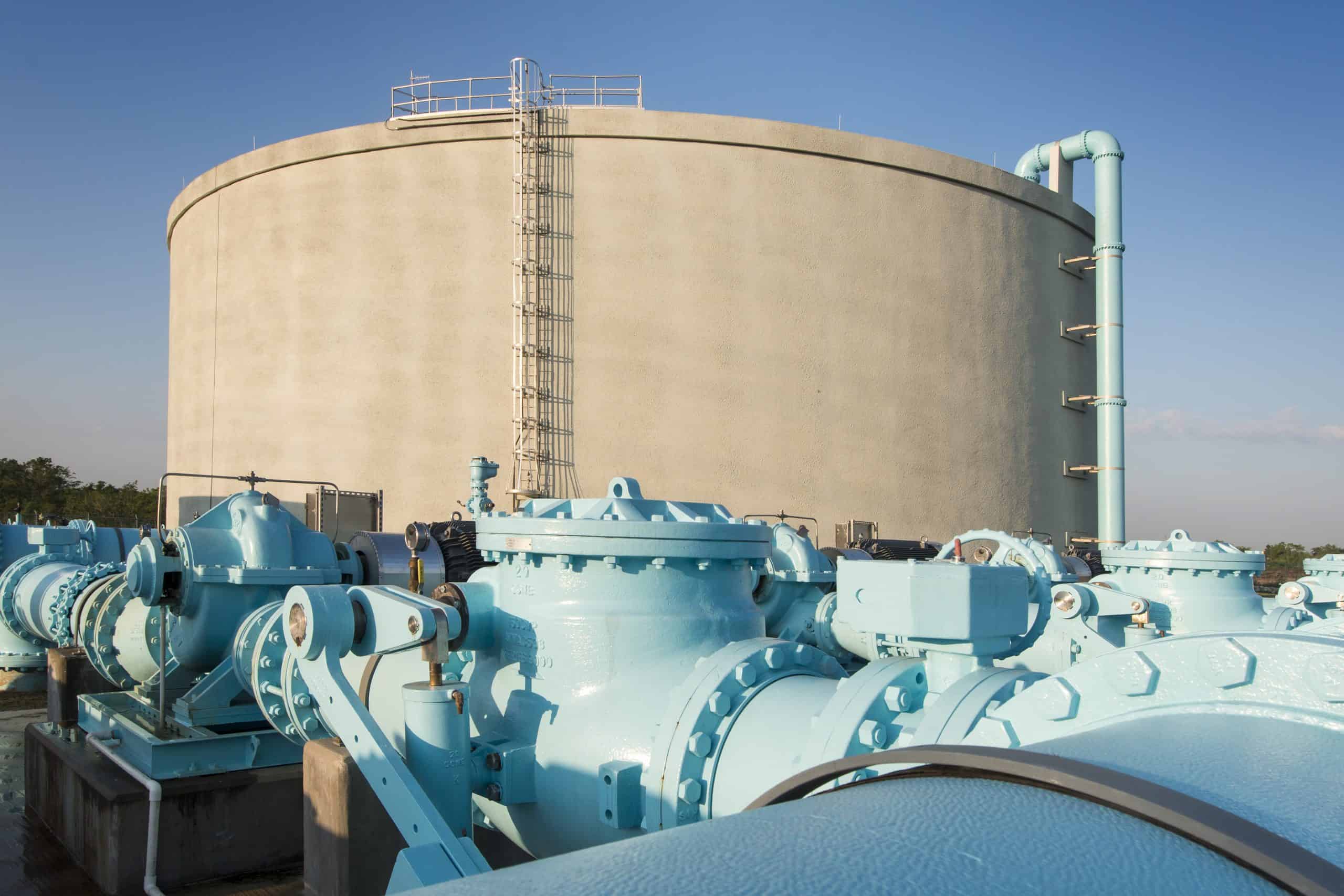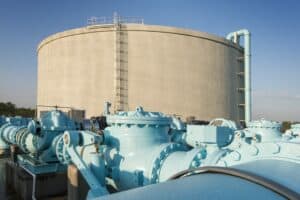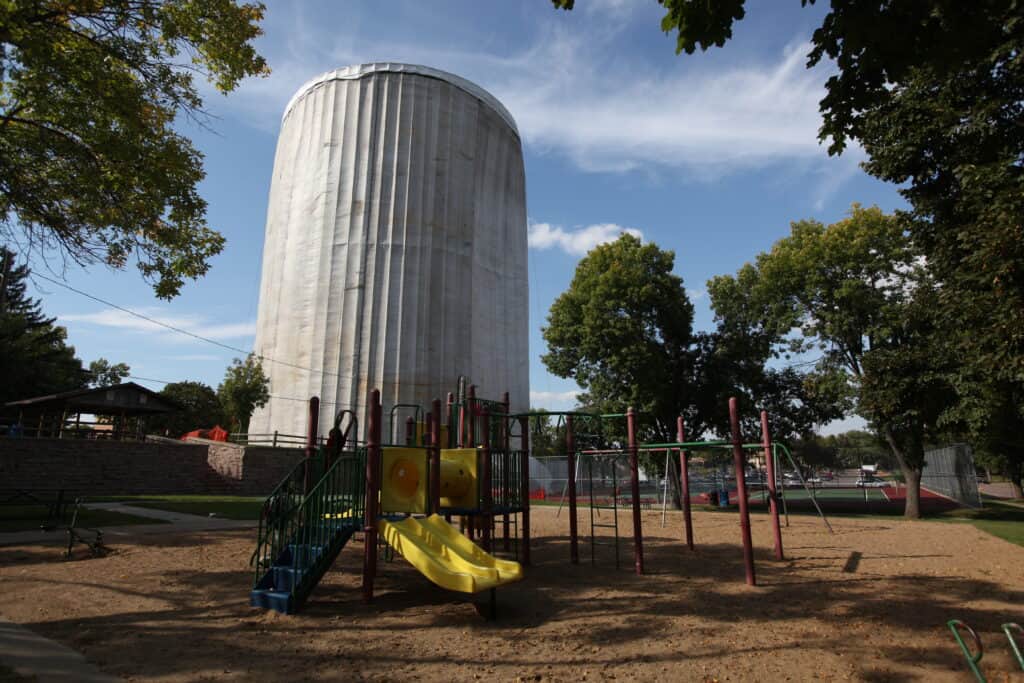
Choosing the Right Water Storage for Your Community is an Important Decision

The purpose of water storage tanks is usually to maintain water service pressure, maintain emergency storage supply and pressure during power outages, and provide equalization volume to meet peak demands, such as fire flows and times of the day when water use is high. It is often desirable to operate wells, water treatment plants, and pump stations at consistent flow rates. Instead of ramping treatment and pumping rates to meet instantaneous real-time demands, equalization storage volume allows for consistent operations and using equalization storage volume to be filled and drained to make up the difference. There are a few items to consider when selecting a new water storage tank for your community or industry.
Traditionally, it has been a common practice for many water utilities to keep storage tanks in full or near full condition to be better prepared for peak water use periods and for emergencies such as fires. As a result, many storage facilities operate with larger water storage capacity than is needed for non-emergency usage. Also, some storage facilities – especially older ones – have an overflow elevation that is below the pressure of the water system. A valve prevents the entry of water into the tank, and pumps are needed to move water from the tank into the distribution system. In these cases, water can reside in the tank for a very long time when sitting stagnant. Long residence times can lead to water quality issues such as loss of residual, thermal stratification during the summer months, or ice formation during the winter months.
Regardless of the type of tank facility, it is critical that the overflow elevation is properly matched to the pressure of the system, as this allows the water surface within the tank to “float” on the system. In other words, the water elevation in the tank itself creates pressure in the distribution system. When tanks are being filled via pump stations, the pressure of the system is increased, and water flows into tank facilities. Normally, the water level in a storage tank routinely fluctuates on a daily basis through a fill and draw cycle. The difference in the fluctuation will vary depending upon the size (diameter and height) of the storage facility, real-time system demand, and location in the distribution system.
The water in the tank should fluctuate several feet prior to the start of the pump station or additional pumps coming online to ensure that proper turnover and mixing of the tank is occurring.
Ground Storage and Elevated Storage – Which is Right for you?
Required water distribution storage capacity for potable water systems is traditionally met by the use of ground, elevated, or standpipe storage tanks or a combination of all three.

Ground Storage Tanks – These are ground supported, flat bottom cylindrical tanks generally with a shell height less than or equal to its diameter and usually constructed of steel or concrete. A storage tank can be broken down into distinctive water storage components, each of which serves a particular purpose. Equalization storage is located at the top of the tank and is typically cycled on a daily basis. This meets the water system demands that are in excess of the pumping capacity of the system or allows storage when pumping is greater than instantaneous demands. Equalization storage can further be broken down into operational storage, low-end storage, and effective storage.
For ground storage tanks providing direct pressure service to the distribution system, emergency storage is defined as the water level in the reservoir above which 20 psi can be maintained for fire flow and emergency service. The upper end of the emergency storage is typically defined as the bottom of the equalization storage component. The water below the emergency storage in the reservoir is considered to be “dead” storage volume and is not considered usable. This “dead” storage, especially if it is a relatively large volume and the tank is not turned over frequently, can lead to water quality problems in instances where internal tank mixing systems are not in place.
- Standpipe Storage Tanks – A standpipe storage tank is also a ground-level water storage tank that is available in a wide range of sizes. Standpipes are greater in height than diameter and can be designed with decorative elements to help blend the tank into the surrounding environment. A standpipe blends the characteristics and performance of both ground storage and elevated storage tank, with their taller design allowing water above the operating range to typically provide gravity-fed pressure. The water below the operating range provides reserve or emergency storage. Standpipes are often used on small systems where less volume is needed, or in situations where a tank site has a high ground elevation relative to the system pressure.

- Elevated Storage Tanks – These consist of two primary components: the tank (or bowl which holds the water) and the supporting structure or tower which supports the bowl. These types of tanks are commonly constructed where the ground elevation is insufficient for the use of reservoir-style tanks or where greater storage capacity than could normally be achieved with a standpipe is required. There are several common styles of elevated tanks including spheroid, fluted column, and composite (steel bowl with concrete support structure). These tanks have commonly been constructed of welded steel; however, recently composite-style tanks are gaining prominence. Composite tanks utilize a steel bowl atop a concrete tower. Composite tanks require less long-term maintenance costs as the concrete tower does not require repainting.
What are Equipment, sizing, and Siting considerations?
In order to pick the best solution for a community, there are many factors that need to be taken into consideration.
- Pumping Systems – Storage tanks may utilize either a direct or indirect pumping system. A direct pumping system pumps water from the tank through a booster pumping station to supply system pressures. In an indirect pumping system, water is pumped into the ground storage tank and “floats” on the system and flows by gravity from the tank to system pressure. Newly designed elevated storage tanks are almost always indirect systems and float at the connected system pressure. The indirect pumping system has several advantages over a direct pumping system in a water distribution system:
- Lowering peak pumping rates, maintain constant, reliable water supply and pressures.
- Stabilizing pressure variations as demands fluctuate.
- Balancing and leveling pump operations.
- Reducing the need for a wide range of pump sizes.
- Decreasing power consumption costs – especially for time-of-day electricity pricing.
- Dampening extreme low and high low pressures (surge relief).
- Enhancing emergency response during water main breaks or power failure.
- Enhancing fire flow and pressure response.
- Size – Typically, storage tanks are sized to hold approximately one day’s worth of water for the community served by the tower. If the pumps fail (for example, during a power failure), a standpipe or water tower should hold enough water to meet the community’s demand for about one day. In addition, the tank may play a major role during a fire and can affect the community’s insurance rates. During a fire, the water demand increases significantly and may greatly exceed the capacity of the pumps at the community’s water plant.
- Height – The elevation of a storage tank and its operational level determines the water pressure in the community. New systems are required to provide a minimum pressure of 20 PSI (pounds per square inch) at ground level at all points in the distribution system under all flow conditions. Typically, normal working pressure in a distribution system will be approximately 60 to 80 PSI and not less than 35 PSI. The water level in the tower must be high enough to supply that level of pressure to all customers in the zone served by the tower.
- Location – Available land for new water storage tanks and the location go hand in hand to also determine the required height of the tank. Water towers are typically located on high ground and tall enough to provide the necessary pressure. By choosing a high site, the height of the tower can be reduced, thus reducing the cost of construction. However, many factors can complicate location selection. For instance, overhead or underground utility cables may need to be relocated. Utility relocations are time-consuming and need advance planning and coordination with the utilities and regulatory agencies. In locating an elevated tank, the following criteria are recommended for consideration:
- Maintain pressure in the distribution system: The tank’s operational elevation is usually 200 feet (ground to overflow) above the service area to maintain a pressure of 60-80 PSI. Higher ground elevations are preferred so that water towers can be less than 200 feet tall.
- Location within a pressure zone: To maximize the benefits from hydraulic water pressure to a pressure zone, the tank should be located in the central portion or the far side of the zone, this allows the tank to supplement demands during peak usage and result in higher service pressures. However, consideration should also be given to the turnover of the tank in order to limit long residence times and the associated operational issues. A tower on the edge of a system may sit stagnant for long periods of time, resulting in low chlorine residuals, thermal stratification, and ice formation. Siting a storage tank requires a balanced approach to maximizing pressures while optimizing water quality and operations.
- Distance from existing water transmission main: Storage tanks require large flows to both fill the tank and drain to meet peak usage. Tank sites farther from high-capacity water transmission mains may require an investment in a connecting main at additional cost.
- Site area, availability, and accessibility: Adequate site area will be required to provide clearance for construction and future maintenance of the tank. The site needs to be available to purchase, preferably undeveloped, to overcome resistance from other property owners. The site shall provide adequate access for construction and maintenance equipment. The costs associated with acquiring the parcel must be considered.
- Foundation Design – Storage tanks and the associated water volume result in a large amount of weight that needs to be supported. Standpipes and elevated storage tanks also need to be designed to resist overturning due to wind loadings. The requirements for Foundation Design make choosing the location of a new water tower important, and sometimes difficult. Engineers must complete detailed geotechnical investigations to understand the underlying soil properties at potential sites. This is an important step to prepare the foundation design for the water tank to resist settlement and overturning.
- Water Age – Water quality is impacted by keeping water in the system fresh. This means turning over the water in the tower and reducing stagnant conditions. Increased water age can lead to deteriorating water quality such as the increased formation of disinfection-by-products (DBPs), nitrification, and loss of disinfection residual. Taste and odor problems can also result from excessive water age. Therefore, the location for the water tower must be selected with an understanding of how water moves through a water distribution system. Poor site location can have a seriously detrimental effect on distribution system water quality.
What are long-term maintenance needs?
Maintenance – Once a location is found, proper water storage maintenance is crucial. Water tanks need to be periodically inspected and cleaned to maintain good water quality in the community’s water distribution system and to help extend the life of the storage tank. Regular tank inspections can also help to identify small problems and prevent major problems from developing that can create health-related issues, leading to expensive repairs or premature structural failure of the tanks. Tanks that are not periodically cleaned can cause contamination events that can harm human health or generate aesthetic complaints.
Typically a community should plan on performing an interior and exterior inspection of their water tanks once every three to five years. Some states require that the interior and exterior of all water storage facilities of 10,000 gallons or larger shall be inspected and maintained a minimum of every five years by a professional tank inspection firm or by a registered professional engineer. In addition, the interior and exterior coatings on steel elevated water storage tanks should be inspected by a person trained to evaluate the integrity of the paint system. Although rare today, tanks painted before the late 1970s could still have a lead paint coating if the original paint had not been removed by sandblasting to bare metal. Making sure this has been done should be the focus of any inspection of older tanks.
Inspections – The timing of inspections can be tricky because a tank needs to be taken out of service for comprehensive interior inspections. The first question to be answered is whether the tower can be taken offline and, if so, for how long. A test shutdown is a good way to reveal any potential challenges prior to conducting the work. Numerous factors will dictate when you can most easily take your tank out of service. Location of the tank, required flow rates, peak demand, the ability to isolate the water tower from the system, and the possibility of ice in the water tower (in winter and spring months) are all considerations that affect the final decision.
Elevated storage tanks are best inspected during the warmer weather between late spring and early fall. If the water tower is susceptible to the formation of ice, inspection is not an option until the ice is completely out of the tower. There are also methods of inspection that can occur without taking the tower out of service. One method is to use a remote-operated vehicle (ROV). Alternatively, inspection divers can be hired to visually inspect the interior surfaces. These alternative ROV/diver methods are usually limited to visual inspections and cannot evaluate the interior coating system to the same extent as a dry inspection allows.
Permits – A permit is generally not required from the regulatory agencies to inspect, clean, repair, or paint a tank. However, a permit will be required if any modifications are made to the tank such as installing vents, hatchways, overflows, or any type of mixing devices. It is recommended that the local regulatory agencies be informed before tank inspection or cleaning. After underwater inspection and/or cleaning, and prior to placing the tank in service, water samples from the tank must be analyzed for chlorine residual and or coliform bacteria. If coliform bacteria are absent and chlorine residual is acceptable, the tank can be placed back into service. If not, continue water sampling until two consecutive samples for coliform are negative. If necessary, the tank should be disinfected.
What systems are evaluated during inspections?
Based on the results of a tank inspection, improvements and maintenance needs may include any of the following:
Paint Recoating – The most common water storage maintenance is repainting. The life of a coating system varies based on the type of product, method of application, and the recoating application. Generally, recoatings are needed within a time span of 15-30 years from the initial application. Given the height and shape of water towers and choices in coating systems with different life expectancies, this can be a complicated process. Tank interior coatings should be coordinated to provide an overall system that meets current standards for drinking water applications, this includes products that meet third-party certification.

Cathodic Protection System – To provide longer coating life and provide a greater level of corrosion protection, a cathodic protection (CP) system can be added to a steel water storage tank. Internal corrosion on steel tanks often begins at pinholes or holidays in a coating system that results in localized, concentrated corrosion and pitting of the steel. CP systems work by installing/suspending an anode inside the tank, which protects uncoated surfaces. There are two primary types of CP systems: 1) passive galvanic systems which use metals such as zinc and magnesium that preferentially corrode over steel, or 2) impressed current systems which utilize an external power source and AC/DC rectifier. When properly installed and maintained, CP systems work in tandem with the coating system to limit corrosion and can significantly extend the time needed for paint recoating. CP systems require regular testing and maintenance to keep the anode systems in working order.
Health and Safety System – Inspections should consider current design standards and safety regulations. Regulations are continually changing, examples include updates to the number and size of access manways, vents, overflow pipe termination height, and proper screening, and fall arrest/safety systems. Regular inspections provide an opportunity to identify any needed improvements to upgrade safety systems.
Tank Mixers – Storage tanks can experience pockets of stagnant water based on a number of factors, including overall tank size/volume, demand/flow in and out of the tank, and the configuration of inlet/outlet pipes. For example, standpipes and water towers that float directly on the distribution system quite often have a single inlet/outlet pipe that connects the tank to the overall system. This configuration often leads to short-circuiting of water through the storage tank, or a “last in, first out” situation. This can result in areas or pockets of water in that tank that sit stagnant resulting in water quality issues such as loss of disinfection residual, DBP formation, thermal stratification, and ice formation.To address these issues, mixing systems can be added to the tank interior. These mixing systems vary in the method used, but can generally be grouped into two types:
- Passive Mixing Systems: These systems utilize the benefit of pressure and flow gradients during fill/drain cycles on a tank to induce mixing. However, passive mixing systems generally do not provide active benefits when the tank is not actively being filled. Examples of passive systems include inlet pipes with multiple ports to increase mixing during filling, dedicated inlet/outlet pipes to increase plug-flow behavior, and check valve systems that can be added to a single inlet/outlet pipe to emulate a dedicated inlet/outlet configuration.
- Active Mixing Systems: These systems utilize an external source of mixing that can be operated continuously. The benefit of these systems is that mixing can be provided at all times (not just the initial filling), which provides greater control of the mixing process. Active mixing systems can include submerged impellers mounted near the floor of the tank, surface aerator mixers, and external air compressors/blowers that create induced mixing with air bubble-induced turbulence. An additional benefit of active mixing systems is that DBPs are volatile and can be removed via air-stripping methods with these mechanical systems. The systems require an external energy source to facilitate mixing.
Determining the ideal storage type, sizing, location, and equipment for each community’s water needs is a highly customized process. Inspections, protective coatings, regulation changes, and equipment upgrades can impact the frequency and intensity of water storage maintenance. Operation needs may also impact the ability to drain tanks for inspections or determine the timing for larger projects like complete surface preparation and recoating of the exterior and interior wet/dry surfaces. Delaying the maintenance of these critical distribution system components could result in water quality violations, customer complaints, and service disruptions. HR Green has extensive experience in designing, constructing, maintaining, and refurbishing water storage tanks for both public and private uses. We’re ready to answer your questions and help your community evaluate water storage options as well as associated operational and maintenance commitments.
Subscribe to HR Green Insights
We're dedicated to providing up-to-date knowledge and insights about the topics that matter most to you. We know how busy you are, so we will keep this simple, covering just one topic per email. Once you've subscribed, you can easily customize your preferences to receive only the updates relevant to you.



